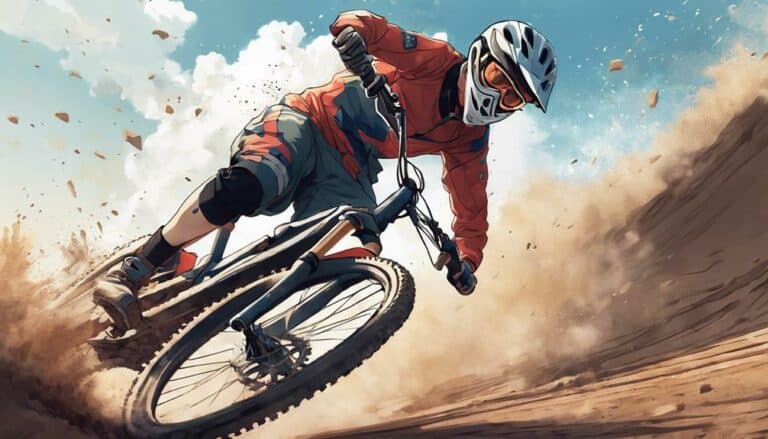When cornering a mountain bike in loose dirt, you must remember to:
- Stay high on the turn
- Release those brakes
- Plan your lines carefully
These techniques are your key to conquering challenging terrain and mastering the art of cornering in unpredictable conditions.
Your ability to navigate these corners confidently and smoothly hinges on your skill in adapting to the ever-changing landscape beneath your tires.
So, are you ready to elevate your mountain biking game and tackle those loose dirt corners like a pro?
Key Takeaways
- Stay high and release brakes for control.
- Lean and shift weight to navigate.
- Focus vision on corner exit.
- Plan lines carefully for optimal maneuvering.
Importance of Cornering Techniques
Mastering cornering techniques is essential for conquering loose dirt trails with confidence and control. When maneuvering through unpredictable terrain, make sure to approach corners with the right mindset. Anticipate the turn ahead, adjust your speed accordingly, and focus on your line choice.
Actually, I'm gonna let you in on a little secret – the key to successful cornering on loose dirt lies in your ability to maintain traction while carrying speed through the turn.
To enhance your cornering skills, practice leaning the bike and shifting your weight towards the outside of the turn. By doing so, you can improve stability and grip on loose surfaces. Additionally, make sure to focus your vision on the exit of the corner to smoothly move through the turn.
Body Positioning for Better Control
Positioning your body correctly is essential for maintaining control and stability while cornering in loose dirt trails. To ride with confidence and skill, focus on weight distribution, balance, counteracting slippage, stability, absorbing bumps, and control. Here's a breakdown of how to position your body effectively for better control:
| Technique | Description |
|---|---|
| Lean towards the outside of the corner | Counteracts the tendency to slide out in loose dirt. |
| Center weight over bike, slightly back | Maintains traction on the rear wheel. |
| Bend arms and legs to absorb bumps | Ensures stability and smoother cornering by absorbing impacts. |
Remember to shift your hips towards the outside of the turn, keeping your head up and looking ahead to maintain balance and control. By practicing these techniques and adapting to changing grip levels, you'll enhance your ability to navigate loose dirt corners with finesse.
Braking Techniques Before the Turn
Before taking on a loose dirt corner, it's important to master the art of braking effectively to maintain control and traction. As you approach the corner entry, guarantee the brakes to confirm your tires can grip the loose terrain.
To manage speed and traction, gently feather the rear brake while keeping the front wheel free to navigate smoothly through the turn. Remember to shift your weight slightly back to increase traction on the rear wheel, preventing any chance of the front wheel washing out.
Utilize the rear brake judiciously to avoid wheel lock-up, which could lead to a loss of control in the challenging conditions. Practice brake modulation to find the perfect balance between controlling your speed and keeping a firm grip on the loose dirt beneath you.
Perfecting these braking techniques will enhance your turning technique and set you up for a successful cornering experience on your mountain bike.
Choosing the Right Line
When tackling loose dirt corners on your mountain bike, your success hinges greatly on the line you choose to ride. Proper line selection can make all the difference in maintaining traction and control through the turn. To choose the right line, consider the following:
- Line selection, traction: Opt for the outside line in loose dirt corners. This position often provides better traction as it allows your tires to grip onto more solid ground on the edges of the trail.
- Trail scanning, smooth lines: Scan the trail ahead to identify areas with more compacted or less loose dirt. Aim to ride through these smoother sections to maintain better grip and stability while cornering.
- High side, berms: When encountering berms in loose dirt corners, choose the high side of the berm. Riding high on the berm helps you maintain momentum and control as you navigate through the turn with confidence.
Practice and Refine Your Skills
Ready to master the art of cornering in loose dirt on your mountain bike? To excel in maneuvering those challenging corners, practice and refine your skills. Start by seeking out diverse trails with varying trail obstacles to gain exposure to different conditions. Concentrate on weight distribution and body positioning to make sure traction and control in loose corners. Experiment with different entry and exit points, aiming to discover the most efficient and stable line through these tricky turns.
As you hone your cornering technique, focus on speed management to tackle loose dirt with confidence. Gradually increase your speed and leaning angles, getting a feel for the terrain while maintaining control. Utilize trail features like berms and edges to your advantage, using them for added support and stability in loose corners. Additionally, practice vision control by looking ahead and anticipating the trail's twists and turns. By refining these skills, you'll become a master of cornering in loose dirt, conquering any trail with finesse and skill.
Conclusion
Now that you've learned the key techniques for cornering a mountain bike in loose dirt, it's time to hit the trails with confidence. Remember to stay high, release those brakes, and plan your lines ahead of time.
By mastering these skills, you'll be carving through corners like a sculptor shaping clay, smoothly piloting the terrain with control and precision. Keep practicing, refining your skills, and enjoy the thrill of conquering those challenging corners!

